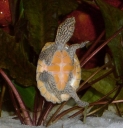Striped-Neck Musk Turtle (Sternotherus peltifer)
Description: The stripeneck musk turtle’s most distinguishing feature are the numerous dark stripes lining the head and neck. The carapace is keeled, and is either gray or brown. Sometimes the carapace will have dark streaks or spots. The small plastron is yellowish and unspotted, and has only one inconspicuous hinge. Two fleshy appendages known as barbels can be found on the chin. Adults range from 3 to 4.5 inches in carapace length.
Habitat: Occurs in creeks, springs, ponds, rivers, and wetlands. Commonly found around snags and fallen trees over a soft substrate.
Range: Sternotherus peltifer ranges from the Cumberland-Appalachian basin of SW Virgina, eastern Tennessee, extreme western North Carolina and NW Georgia through northern and western Alabama, eastern Mississippi and Louisiana.
Diet: This species is omnivorous, but it prefers small snails and aquatic insects.
Reproduction: Almost nothing is known of the reproduction of S. peltifer compared to S. minor. Mating, which has not been described, probably occurs in spring and fall months. One female with two oviductal eggs was captured on 18 June 1987. She also contained three corpora lutea, indicating one egg was laid before capture. Presumably, nesting occurs mid-May into July, as in other turtles in this region. Size at maturity for a composite sample from throughout the species' range was 2.35 inches CL for males (3-4 years old) and 3.55 inches for females (6-8 years old). It was found that females matured at 2.35 inches PL (about 3.15 inches CL) in a Florida population. Clutch size in S. m. minor from Florida is one to five. In Virginia, egg size of S. peltifer was 1.15 x 0.65 inches; they averaged 0.2 ounces, well within the values reported. Incubation time was 84 days and hatching occurred on 14 September.
Adults mate in spring resulting in female egg laying through the summer. Females lay several clutches of 2-3 hard-shelled eggs in nests dugout of loose organic material near streams. The young hatch out after 8-16 weeks.
Status: The completely aquatic habits of this species leave it vulnerable to some forms of toxic chemical contamination. Its reliance on mollusk prey makes it a secondary target of pollution effects on mollusk populations. The fly ash spill in the Clinch River in the 1970s undoubtedly eliminated this species in many areas because of the nearly complete elimination of the molluscan fauna. The population ecology of this species needs to be studied to identify the vulnerable stages of its life history and to determine how it responds to changing environmental conditions.
Taxonomy: Upgrade to species status in 2020 from Sternotherus minor peltifer to Sternotherus peltifer.
»» Kingdom: Animalia - Animals
»» Phylum: Chordata - Chordates
»» Subphylum: Vertebrata - Vertebrates
»» Class: Reptilia - Reptiles
»» Order: Testudines - Turtles & Tortoises
»» Family: Kinosternidae - Mud & Musk Turtles
»» Genus: Sternotherus
»» Species: Sternotherus peltifer - Striped-Neck Musk Turtle
»» Subspecies: None
This article uses material from the Wikipedia article "ANIMAL", which is released under the Creative Commons Attribution-Share-Alike License 3.0. Content may have been omitted from the original, but no content has been changed or extended.
|








